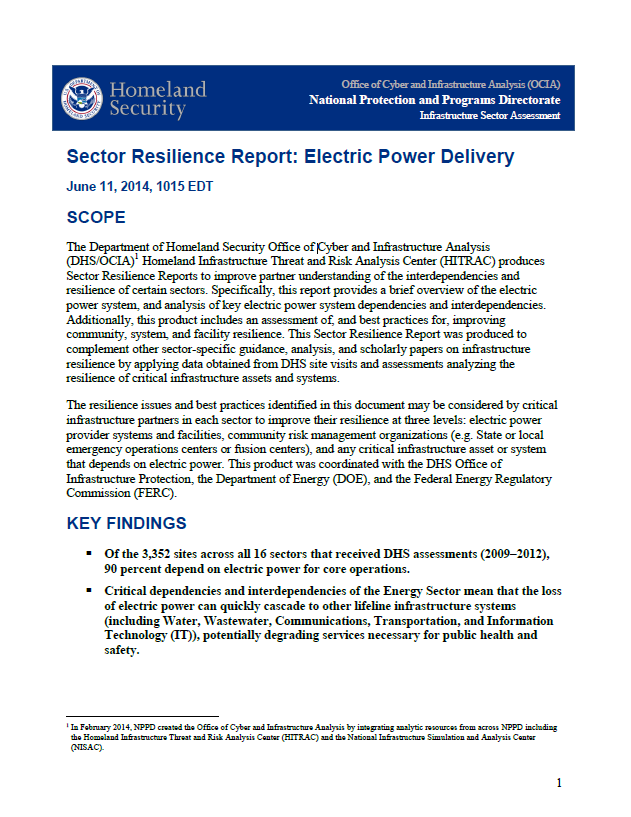Office of Cyber and Infrastructure Analysis (OCIA) National Protection and Programs Directorate
- 18 pages
- June 11, 2014
The Department of Homeland Security Office of Cyber and Infrastructure Analysis (DHS/OCIA) Homeland Infrastructure Threat and Risk Analysis Center (HITRAC) produces Sector Resilience Reports to improve partner understanding of the interdependencies and resilience of certain sectors. Specifically, this report provides a brief overview of the electric power system, and analysis of key electric power system dependencies and interdependencies. Additionally, this product includes an assessment of, and best practices for, improving community, system, and facility resilience. This Sector Resilience Report was produced to complement other sector-specific guidance, analysis, and scholarly papers on infrastructure resilience by applying data obtained from DHS site visits and assessments analyzing the resilience of critical infrastructure assets and systems.
The resilience issues and best practices identified in this document may be considered by critical infrastructure partners in each sector to improve their resilience at three levels: electric power provider systems and facilities, community risk management organizations (e.g. State or local emergency operations centers or fusion centers), and any critical infrastructure asset or system that depends on electric power. This product was coordinated with the DHS Office of Infrastructure Protection, the Department of Energy (DOE), and the Federal Energy Regulatory Commission (FERC).
KEY FINDINGS
Of the 3,352 sites across all 16 sectors that received DHS assessments (2009–2012), 90 percent depend on electric power for core operations.
Critical dependencies and interdependencies of the Energy Sector mean that the loss of electric power can quickly cascade to other lifeline infrastructure systems (including Water, Wastewater, Communications, Transportation, and Information Technology (IT)), potentially degrading services necessary for public health and safety.
Of the 41 electric power substations assessed by DHS, 59 percent depend upon an external source of electric power for on-site operations, 62 percent depend on communications, and 77 percent depend on IT to maintain operations.
Interruption to IT supporting infrastructures, including the loss of electric power, could limit the operating flexibility and efficiency of electric substations and system monitoring equipment. A large-scale IT disruption could potentially impact power delivery to other critical infrastructure assets in the electric service area.
…
The electric power delivery system faces a broad range of potential threats and hazards, ranging from cyberattacks to a variety of natural hazards, including various weather-related phenomena (as shown in Figure 1). Electricity infrastructure is highly automated and controlled by utilities and regional grid operators that rely on sophisticated industrial control systems. These control systems may be vulnerable to cyberattacks that could potentially disrupt electric power production or transmission. Accidents or physical attacks on electric power infrastructure, such as targeted shooting of transformers or intentional downing of power lines, also pose a threat for the Sector’s continued reliable operations. Natural events such as hurricanes, earthquakes, winter storms, wildfires, and solar flares also present a significant hazard to the electric power system, as these events occur regularly and have the capacity to cause extensive and widespread damage. Such threats and hazards can cause extensive damage to electric power systems, but due to system resiliency the effects may not result in significant power outages.


